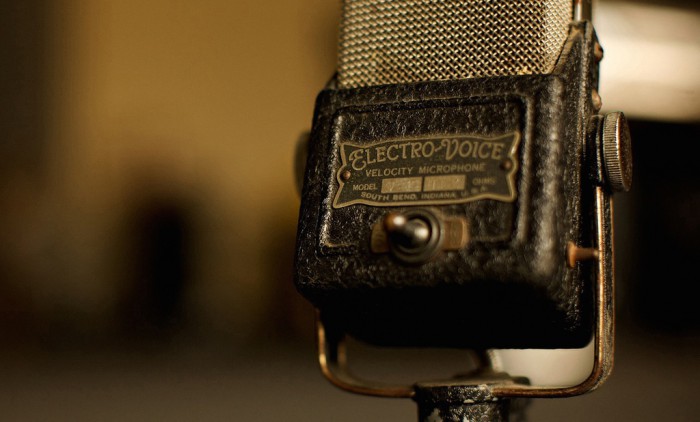
I spoke to several people working on new (and newish) podcasts for their news organizations. We talked about production challenges, how the audio content interacts with print and web, figuring out their audiences, and more. Their responses, below, are condensed and lightly edited.
Lillian Cunningham, editor and feature writer of the Post’s ‘On Leadership’ section:
It hasn’t been a fast way for me to learn about the presidents, exactly, since these episodes take a lot of work! But it has created something that’s a fast way for others to learn. And it’s certainly been fun.
The Post does have a few other podcasts. I started an On Leadership podcast in the fall of 2014 that features 20-minute interviews with leaders in business, government, and the arts. That was just a single interview with a standard intro at the beginning. Presidential is a much larger and more complex project, but the prior experience gave me a good starting point.
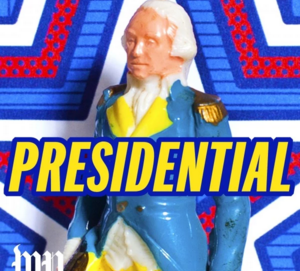
My colleagues Lisa Bonos and Tim Bontemps have both started conversation podcasts in the past year, called Solo-ish and Posting Up. I’d say Presidential is the first podcast here, though, that is structured as a series. It has a narrative style and a story arc that spans the length of a fixed number of episodes.
It’s very much a reporting process. I started by researching and reading up on each president, in order to think through the themes that would be interesting to focus on and to identify the major historians who have expertise on a given president.
Since part of what I’m interested in exploring is the question of legacy, and why we remember certain presidents the way we do, I decided it would be important and interesting to also weave in the voices of journalists who write “the first rough draft of history,” as Phil Graham said. For that, I’ve been talking to a lot of my colleagues around the newsroom to get their perspective on interesting questions to explore that still have resonance today.
The format for each episode, which will typically be a mix of interviews bonded together by narration and storytelling, is guided by the most fascinating things that the research and interviews reveal. I want to keep the format somewhat flexible, though, so we can give each episode the treatment that best suits it. For example, we’ll have audio from speeches to work with for later presidents that we obviously don’t have as a storytelling device for the presidents in earlier episodes.
We also want to keep the episodes creative and surprising so, as another example, we’re planning to structure part of the episode on Ulysses S. Grant as a book club discussion of his autobiography.
It’s important to use the podcast as the primary medium for telling the story, and to recognize that we would make different choices about how to tell the story if we were telling it on a different platform. For that reason, we’re not publishing full text transcripts of each episode, but we are publishing short blog posts that give some more background on the episodes and, in some cases, link to source materials.
I’m also very excited about the ways we plan to use Instagram and Twitter over the course of the series. I see those as additional storytelling devices that don’t overlap with the podcast. They’re a way for us to provide readers with visual information — great historical photos, archived front pages from election night, copies of presidential letters — that an audio podcast obviously can’t provide.
We have an in-house recording studio, as well as recording equipment I can take with me off-site, so I do all the interviews, taping and editing myself. Many colleagues have lent their voices and great ideas to the series, though.
I don’t think I realized just how many people would get really excited to learn we’re doing a podcast about presidential history! That’s been a wonderful surprise. Currently we don’t run any ads within the audio of the podcast itself, but that may change at some point.
I definitely want to make the podcast interesting and appealing to a wide audience. I’m excited that there are a lot of history buffs out there who want to listen to it, but I’m even more excited that people who never thought they would listen to a history podcast are finding this useful and engaging. That’s really a key part of its mission — bringing the general public into a conversation about America’s leaders.
One of the biggest challenges has been deciding what to focus on for each episode, when there are so many fascinating directions that we could potentially take each conversation. Making the decision to commit to exploring one topic over another one isn’t easy.
I know it might sound like semantics, but I don’t really think of this as an experiment. I think of it as a project we’re pouring ourselves into because we think it’s meaningful, exciting and worth doing — and the side bonus is that we’ll of course stay curious and thoughtful along the way about learning from it for future endeavors.
Steve Byrne, arts and entertainment editor:
When we started our documentary podcast [accompanying the Free Press’s Film Festival], it was a stretch for me, but it set me up to make Detours easier.

We wanted this to be very local, and I knew I wanted to bring in someone from outside the paper. My role on Detours is more as a producer and on-air sidekick. Our host, Rob St. Mary, does the vast majority of the solo interviews for the podcast, and he also produces. Rob has 15, 20 years of professional radio experience and has also covered arts and culture. If I didn’t know he was out there, I wouldn’t have pitched this idea at all.
Putting together the podcast is just the two of us, going back and forth. Rob records and edits and sends me the final product. I get it up on the website and on all our other channels, with some help from our tech people.
We wanted to land somewhere in between public radio and podcast, a little more produced, a little bit more edited.
Podcast audiences are, across the spectrum, a little younger than our traditional readership. So we’re actively trying to book guests in a way that will appeal to younger audiences, and when we look at stuff to put into the show, our editorial choices lean that way.
Beyond that, we’re using it as a vehicle to get stuff we might not otherwise be getting into. There’s a lot going on in the Detroit arts and culture scene, and our staff is not as big as they used to be. This provides another outlet for us to cover stories. Some people will say, “No! You didn’t cover it. It’s not in the print papers.” But as far as I’m concerned, if it’s in the podcast, then yes, we did cover it.
Here’s an example. Jack White from the White Stripes opened one of his Third Man Records stores back in November. Jack is originally from Detroit. His coming back to town is a pretty big cultural story for us. Our pop music writer spent time over at the record store talking to the principles involved, and wrote a story that ran on 1A of the paper. At the same time, Rob did an interview with the key employees at the record store.
Jack White's @ThirdManRecords opens in #Detroit. Our Detours podcast talks with co-founder. https://t.co/z8w8Th31DJ pic.twitter.com/yqIGEuR9tP
— Detroit Free Press (@freep) November 27, 2015
When our entertainment reporters have reported cool and interesting stories, we have them on as guests — we can incorporate the reporters without adding too much work onto their backs.
Every episode gets print promotion. We have a weekly entertainment tab that runs on Thursdays, which runs summaries of what’s in the episode and says how how you can find out more. We trumpet this in multiple ways.
We don’t have ads yet. People are cognizant that if this is going to be long term, ads or sponsorships will be needed. Our business side and newsroom leadership have been looking really hard at finding ways to create an umbrella brand for all the entertainment content, to get a partner or sponsor involved with the many things produced on the entertainment side. Detours is one piece of the puzzle.We’re working on getting a handle on our iTunes analytics, which is difficult. We only recently added Soundcloud, and have had several thousand listens there. Those aren’t the kind of numbers that are going to cause anyone to declare a media revolution. But my understanding is that a good episode of Detours will get around several thousand listens on the Free Press website.
We’re only a few months in. In the long run, we’ll probably need higher numbers to be declared a success, but I feel very positive about the steps we’ve already taken.
Rob St. Mary, Detours host:
I’m not allowed to work out of the Free Press offices, because I’m a freelancer, and that could lead to trouble with the newspaper union. Therefore, each week we are pretty much on the road. We find a venue, talk to them, add that in as part of the mood of the show. Working “on location” is tough, at times, because you have to deal with less-than-ideal sound environments — echo, construction, loud traffic, cell phones. But the “on location” sound adds an aspect of “you are there” to the show, and Steve says it has introduced him to people and places he was not aware of.
One of the things that’s great for me about the show is that we created the rules. Working in radio, there’s an attitude of “this is the way we’ve always done things.” Working with Steve at the Free Press, the attitude is, “We have never done this, so how can we do it?” That’s really the best thing you can ask for as a creative person within the confines of a traditional media outlet.
You really want a guest who is not only knowledgeable, but listen-able. I love process, the psychology of why and how people do what they do, and I think that plays well to a conversation.
I’ve always believed content is king. Good content will drive people. That’s why Serial worked. That’s why WTF with Marc Maron is a favorite. That’s why podcasting’s biggest success stories have worked. It’s the content first, then the push behind it. The ability to experiment, to break format — no need for a 30- or 60-minute show — and create new ideas are some of the best things about the world of podcasting today.
Gina Barton, law enforcement investigative reporter:
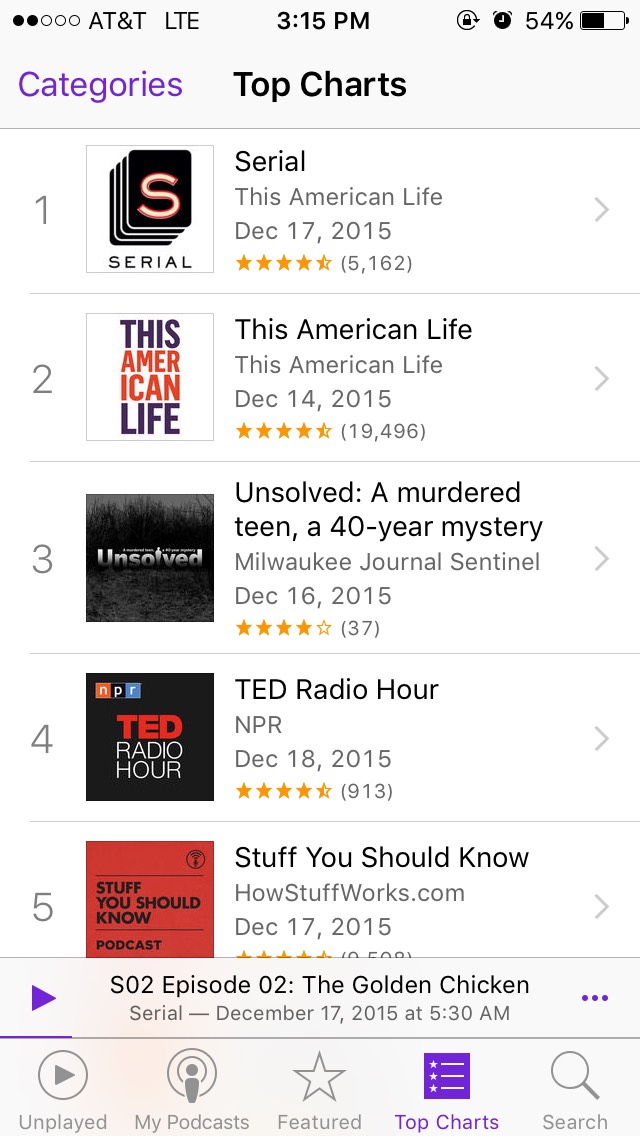
I’ve done these types of narratives for the past 20 years, but usually they run every day, seven days in a row. But we decided it could be a win-win situation if we rolled out one per week, because people could get hooked on it.
We really tried to make the podcast a value-added thing, so that if people were reading the written version of the stories online and then listened to the podcast, they wouldn’t get just the same thing.
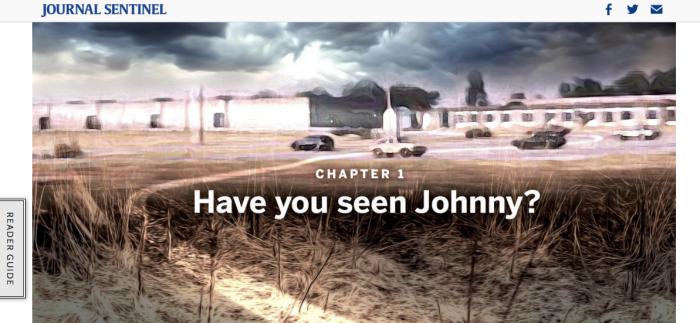
On the podcast, it’s really just Katie and me, and another senior multimedia journalist, Bill Schulz, who also helped us learn many of the the technical things: how to get the levels of the music right, how to take out my breathing in some places, recording some of the audio. This is completely new to me.
There were a couple of situations where I was out in the field reporting, but I wasn’t focused on getting higher-quality audio as I should have been. For instance, a detective involved in the case came in and spoke at a criminal justice class I was teaching. I recorded it and we used some clips, but compared to the quality of the studio audio, it wasn’t as good, because I wasn’t attuned to what would make good ambient audio.
People told me, “You sound really natural, and it doesn’t sound as scripted.” That’s because it really wasn’t scripted! This was Katie and Bill’s brilliant idea. Katie went through the written version of the story and came up with questions she wanted answers to, some about the story and some about the reporting of the story. She and I would sit in the recording booth, and I would just talk to her. After that she would transcribe our conversation, and I would go through the audio and find clips. For the weeks we’ve been releasing the show, we’ve been on deadline 24 hours a day, for seven weeks, which is exhausting!
I wonder if we’re being helped by the fact that in Serial season two, the Bowe Bergdahl story is not true crime-related the way season one was, yet a lot of people are still interested in the type of storytelling in the first season. We always tried to have a national angle. My hope was that it wouldn’t really matter to people where this happened — it’s just an interesting story with universal themes that people could relate to.I’ve gotten emails from people in other states who are just discovering this. Listeners and audience members ask when we’re doing season two. Through various channels (including a mention on Reddit), we were able to reach the audience that is interested in following our stories in the audio format.
We’ve put it up online and put blurbs in the paper. When the paper version ran, we had our own shortcut online to the podcast audio page, so that people could go directly to that if they wanted to. We were also promoting separately on Facebook, Twitter, and Instagram.
We cooperated with our local NPR station WUWM: They’ve done two interviews with me throughout the course of this series; they were promoting the project on their site as well. In February, the 40th anniversary of John Zera’s death, they’ll air the entire podcast series. The plan is, if the case is solved, we’ll do one more episode on it. Even if they don’t solve it, we’re thinking of doing an update then.
Bill Rankin, senior legal affairs writer:
I had this case that I’d been reading about already, because so many people had been contacting me about it. It was the Justin Chapman case. Litigator Mike Caplan, who represented Chapman and is featured in several episodes of the podcast, told me he thought the man was innocent. That obviously got my attention.
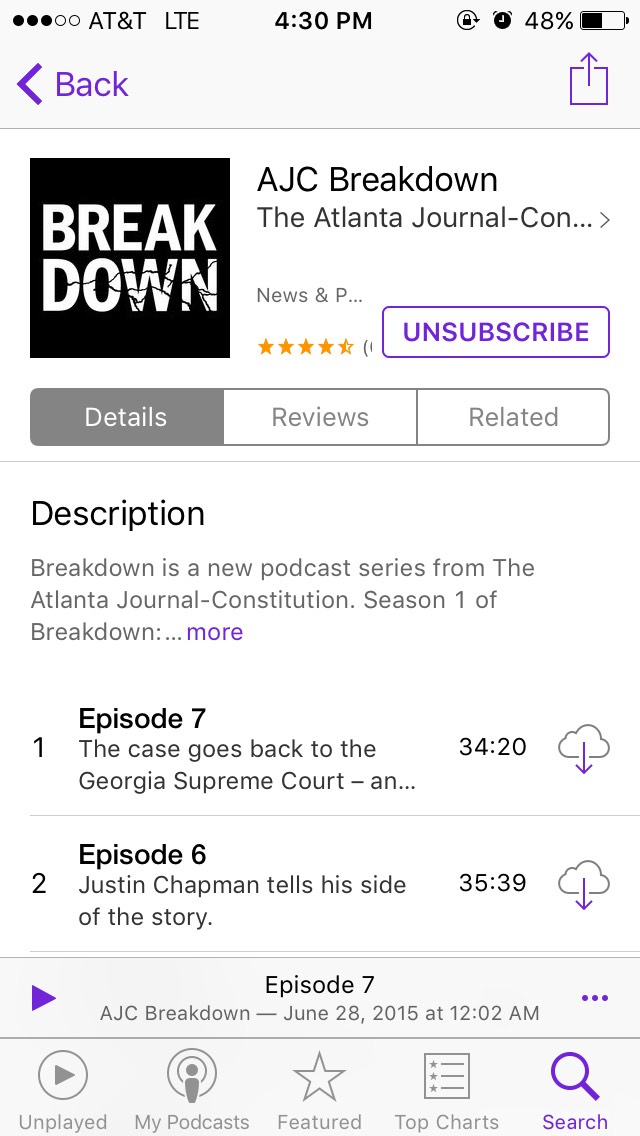
Finally, I finished reading everything and interviewing everyone — I was covering a trial at the time, and I couldn’t do this particular case right away, but in my spare time I was reading all the transcripts and court files and getting up to speed on this case, which I was fascinated by. It had all sorts of problems every step of the way.
We had an editorial meeting, and I remember being asked if I was willing to do this story as a podcast. I said okay, though I had no idea. I’d never done anything even remotely like that — I’m a print journalist. I was taken off the trial I’d been covering and spent nearly six months working on the podcast.
A lot of people worked on other parts of it. We made a special website for it. [Editor] Richard and a producer worked on it with me. We had full editorial control; people trusted us to do it right. We hired a story consultant, Susanna Capelouto, who came from public radio — she was a longtime public radio reporter and broadcaster here in the Atlanta area. We hired a studio, Company 3 in Atlanta, and worked with their sound engineer. I learned a lot from him, and he made me sound a lot better.
Susanna told me very early on how important audio was. I needed to make “sound boards,” where I would get audio tape and listen to that tape and figure out the best parts and passages to use. I needed to take note of the timing when I wrote the script, so we would know exactly where we needed to insert additional sound. That early advice was a big help.
I’ve covered courts and legal affairs for a long time. When I told lawyers and judges I was doing this podcast, some of them didn’t even know what podcasts were — though it really wasn’t a problem after I explained it to them.
We went through a lot of trouble to get tapes of Chapman’s trial, to get tapes from the habeas hearing. The sound quality was not nearly as good as we wanted, so we tried to use it as sparsely as possible. You need to have great sound if you want to draw people in. You need good sound, you need good interviews, and all sorts of scene noise.
When we went on to write the script, we would write it the best we could. Then I’d quietly go somewhere and read it. I’d usually have to rewrite it. I’d have to enunciate certain phrases, different phrases, because when you finally read what you’ve written aloud, you realize it’s totally different. You have to be writing differently, because you’re speaking.
I’m not privy to all the numbers, but I know iTunes has a news and politics category, and [Breakdown] was in the top 100 when it was ongoing. We found that even after we stopped promoting the podcast, it still traveled around. And back in August we found a lot of people in other places listening to it; people in London, in Chicago. Obviously we’d like to have millions and millions of listeners like Serial had, but we had no idea what to expect. We’d never promoted anything like this before.
We got a really good reception from listeners, and we’re thinking of doing another one. And yes, I did get other tips during the course of this airing, and no, I can’t say what they are!
Jason Noble, political reporter:
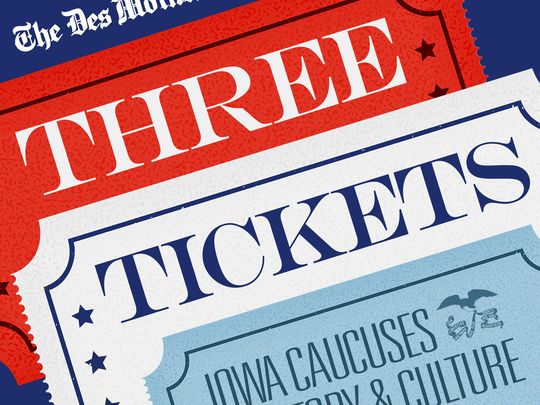
We wanted to consider how we could tell this story of the whole sweep of the history of the caucuses in a podcast. We came up with a general idea, and started reaching out to people. I had the opportunity to go to D.C. for a conference, and there I was able to schedule Joe Trippi and Bob Dole, and made those episodes as we went along.
I conduct all the interviews, transcribe the tape, figure out the story, write the voiceover, and give that whole package to a freelance engineer we hired. The engineer puts it into the software, adjusts the music, and we have an editing process back-and-forth.
I have to really credit my editors. I spent a good five or six months where I pretty much neglected everything else and just worked on this, and they were cool with it. They hired freelance engineer before there was any material, before we knew whether there could be a revenue component to this.
From the start, I’ve conceived of this as a national product. I tried to balance who we talked to: some national names that everyone in the political word knows, some Iowans with really interesting histories. It’s the first time The Register has done a show that’s this produced, though some of our sports reporters have radio shows or a standing appearance on radio shows.
One of my favorite episodes is about how caucuses really work — the actual mechanics of it. I tell the story of the debacle of the 2012 caucuses [which involved a razor-thin victory and large-scale miscounts and missing data]. I go into a lot of detail, excruciating detail, and there’s no way you could read that in print. It’d be so boring your eyes would glaze over. But when I can set it up in the podcast as conversation between me and an expert, it engages your attention longer.
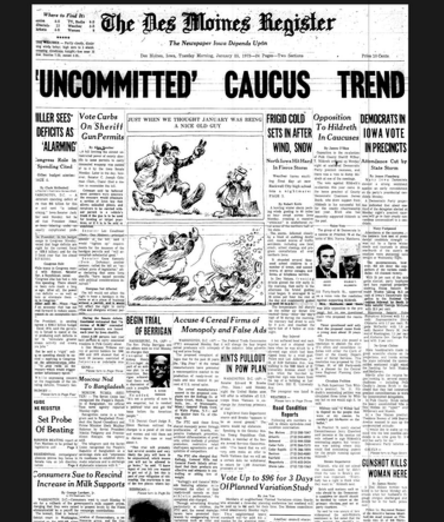
I interviewed Republican Party of Iowa Chairman Matt Strawn, who gave me this wonderful interview. It was so reflective. He really took responsibility for how things went that night in January [at the 2012 Iowa caucuses]. The story was told in his voice. We told that story in the papers in 2012, but this was a definitive explanation of how that night unfolded.
The timing of this was important. We started releasing the podcast from October through December. The Iowa caucuses are on February 1. Then we’re not going to really exist anymore in the same way for another two or three years. I wanted to have the series exist in its entirety before national interest vanishes.When I first started the podcast, I got it into Politico’s Playbook. I’ve done quite a lot of radio interviews, local and elsewhere. I’ve done an interview for Sirius FM — they had me on for about ten minutes to talk about the podcast. The audience challenge was a big one: how to get it in front of people, and also how to gauge success. We don’t have great metrics. But for me personally, this has been an incredibly fulfilling project, one of the most important gratifying things I’ve ever worked on as a journalist. There’s great potential for building out the Register’s audience.
We didn’t, in the end, sell the podcast. We had some discussions with Panoply and shared a few rough cuts with them, but in the end we had to move on because of our timeline. With a podcast, theoretically, there’s an advertising market. If I can somehow pioneer something at a Midwestern metropolitan paper, that would be great!